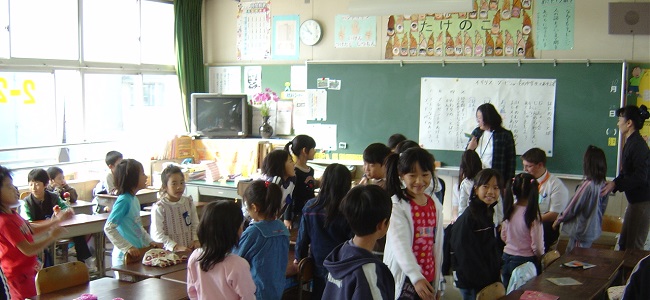Welcome to Japan.
Foreign visitors to Japan often work as assistant language teachers (ALTs), which means they team-teach with a Japanese English teacher. Sometimes it means they lead the class—or they repeat only what the Japanese teacher requests. Teaching in Japan requires a strong sense of flexibility, but the rewards are many.
The Teacher’s Role as a Motivator
One astonishing fact about the Japanese education system is that students cannot fail a course. They cannot be held back a year. Their participation and grades carry very little weight in their progress through public schools. Unlike the US, however, Japanese students must pass examinations to gain admittance to high schools, which often offer specialized curriculum like vocational training, college preparation, and so forth. If a student could not pass them, they would join the workforce in whatever job they can obtain.
This is rare, however, as there is often tremendous social and parental pressure to at least make it into high school.
This approach to education means that student motivation is paramount. If the student isn’t already interested in the subject, and the teacher cannot motivate them, they often spend the class doodling, talking to friends, or put their heads down for a nap. English is a compulsory part of the curriculum until high school, when it becomes an elective. Varying lesson delivery, incorporating games into the instruction, and keeping the students physically moving can go a long way towards piquing their interest and investing them in the subject.
No one likes lectures.
Differences in Discipline
Education is compulsory through junior high school in Japan, which the Japanese interpret to mean students cannot be suspended or otherwise removed from school for anything less than criminal arrest. If a student is disruptive, you cannot send them to the principal’s office. Punishments for anything other than blatant rudeness are rare and even then are confined to a formal apology.
This makes it critical for you to make a good impression up front, be approachable, and entertaining. You won’t have any stick to use, so your carrot must be delectable and tempting. Students will make jokes and offer insults. If you can’t laugh louder and turn it around, you will lose control of your classroom—and likely never get it back.
Don’t take yourself too seriously, be willing to look the fool on occasion, and know how to turn a joke around and run with it. Grow some thicker skin and keep your energy up. Attitudes are contagious, so staying light and funny is a good way to keep your students in a similar mood.

Technology Equality
It often shocks people when they discover how low-tech Japan really is. Faxes are second only to snail mail as a means of document sharing. Offices float on a sea of paper, and schools are no different. Most classes do not employ computers in education, much less the Internet. Public schools usually have the budget for a computer classroom, but students will do most of their work in notebooks, workbooks, or printouts that the teachers produce.
Unlike most American schools, which have a computer resource specialist, whose objective is to incorporate technology into learning, Japanese schools must do without.
This doesn’t mean you can’t incorporate it. For example, my smartphone is a faster way of translating a student’s question than puzzling it out one keyword at a time. Likewise, I use my laptop to record students as they read, so they can listen to how they sound and make any needed changes in their speech. I can also record written passages, such as for listening tests, and make custom audio CDs for my teachers. Visual aids are good and students respond well to pictures, but show them a video clip and you’ll have their attention. Tablets work well for that task as they aren’t bulky and you can move them around the room.
At the minimum, you need to employ visuals in your lessons, but why not go all the way and deliver a spectacle?
Group Mentality Trumps Individuality
One of the challenges with teaching in Japan is drawing students out. Asking the class a question and hoping to get an individual response won’t likely bear fruit with older students. Younger classes tend to be more genki—more energetic—so they will often reply, usually as a group. Individuals don’t want to stand out in Japan, whether or not they know the answer. They will go to great lengths to avoid risking embarrassment, which makes small groups ideal for interaction practice, shared assignments, and games.
Because the Japanese education system focuses on final examinations over assignments, it’s not uncommon to see students exchanging papers to share the answers. As an assistant language teacher, your role isn’t to enforce the rules, but rather to improve comprehension. When I see kids doing that, I make sure they’re sharing the correct information.
Teachers in Japan are also part of the group, expected to volunteer with enthusiasm. As a foreigner, you won’t be held to the same standards, but making the extra effort to clean up each day (there are no custodians in Japanese schools), attend after-hour events, and assist your teachers with marking papers, making photocopies, or developing lessons will go a long way to improving your standing.
Teaching in Japan offers a lot of unique experiences. You will rarely encounter children more involved in their own education, who want to learn and interact. Rather than fighting the differences, accept them and work with the system instead of trying to impose a new one. Bring a volunteer spirit and a willingness to learn.
You’ll come out ahead.
Do you have any experience teaching in foreign countries? Let us know in the comments below


















